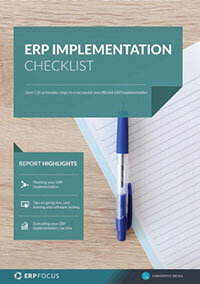The top three ERP implementation best practices
Once your ERP is chosen, the time for implementation begins. Benjamin Franklin said, “If you fail to plan, you are planning to fail.” We do not want our ERP implementation to fail so here are some best practices for your plan.
Create a plan
Start with the prioritized requirements you set when selecting your ERP. Ensure these are visible to all throughout the implementation so that none are inadvertently missed in the process. Develop some KPI or key process indicators for the implementation and communicate these indicators with the entire enterprise. All will know what your team is doing and how you progress during the implementation phase.
All your implementation team should completely understand the flows of your chosen ERP. When a new sales order is entered, what happens next? What happens when a transaction to add labor to a production job causes an error signal? You will need the support of your ERP vendor here as they should know already and can help lead you through the processes. This understanding is critical. The programmed flows will not match your existing process flows completely. They are not wrong; there is more than one way to accomplish the desired results.
Manage change
All of us, as people, resist change to some extent. That resistance to change can take many forms ranging from a little hesitation until the change is understood to a complete emotional breakdown in a very few. Be prepared to help all your users adapt to your new ERP.
Communicate regularly with executive management and all your users. Why is the enterprise making this significant change? What problems or concerns do you expect to resolve? What other benefits should be expected? Ideally, there should be benefits for every user but the change should be neutral at the worst. No user should see the future as bleak.
Lay out a training plan that provides every user with grounding in their own transactions as well as precursor and successor transactions other users will make. There should be an overview training course for everyone that demonstrates the overall system for the business and basic transaction and screen navigation.
Be smart with your legacy data
Your legacy system(s) have data that might go back for decades. Users are familiar with that data and know how to find what they need. That data requires storage space and might exist in a variety of formats so this is the time to clean up historical data and choose what data you will load into the new ERP.
There is static data, such as customer or supplier names and addresses. In addition, there is dynamic, transactional data such as the shipment of an order to that customer sometime in the past.
With your static data, weed out those customers who have not done business in the recent past. If they place another order tomorrow, simply treat them as a new customer. Examine all the records you plan to migrate and correct any errors now so good, clean data is populating your new ERP.
Clean up the dynamic data too if there are problems. The important choice here is how much data to migrate. Generally, the current year and perhaps the previous year are enough. If there is a need to dig deeper into the past, keep the legacy system working in a read-only mode as long as needed.
File layouts in the new ERP will not match the layouts in your legacy system. There could be legacy fields that the new ERP will not need. There might be fields needed in the new ERP that do not have a precise match and must be built up through a manual system.
These are not the only implementation practices but you should get the idea how to develop your own implementation that leads to a success for your business.
Free white paper

ERP Implementation Checklist
Over 120 actionable steps to implementing a new ERP successfully

Featured white papers
-

ERP Implementation: 9 steps to success
The 9 proven steps you should follow when implementing ERP
Download -

ERP Implementation Checklist
Over 120 actionable steps to implementing a new ERP successfully
Download -

Manufacturing ERP Implementation Checklist
Over 70 actionable steps to rolling out new manufacturing ERP software
Download
Related articles
-

The case for multi-tier ERP implementations
Learn more about multi-tier ERP implementation and why you might need one
-

Secret KPI: Why Your ERP Implementation Team Matters More Than Software
Learn how Godlan ensures successful ERP implementation for manufacturers with proven strategies &...
-

An example ERP implementation team structure for your project
Learn about three key elements of an ERP implementation team and the individuals who contribute w...

